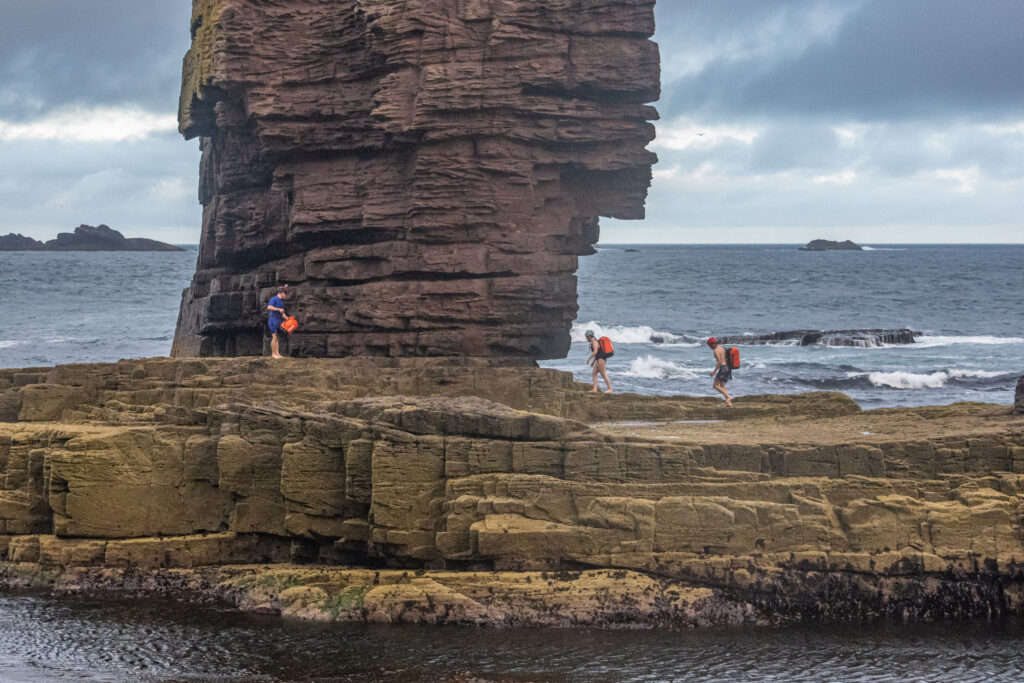A Climbing Guide to Am Buachaille
Almost at the most North Westerly point of the country sits one of the UK’s classic gems of climbing – Am Buachaille the Herdsman/Shepherd of the north west – this is a guide for those wanting to climb the stack but don’t know where to start or want more information! Firstly we need to stress that this is a full on climb and the seas can be a bit gnarly so if you are in doubt at all, it is worth hiring a guide to climb it or the other sea stacks.
Near Cape Wrath sits Sandwood Bay – this bay is one of the most beautiful beaches in Scotland, and is 2 miles of pristine sand, beautiful waves (good surfing) and stunning views across towards Am Buachaille slightly to the west of the beach which looks imposing straight away. This stack sits 100m off shore at high tides or 10m off shore at low tides and at mid height the pedestal of rock it sit upon is fully covered over by the seas and the waves can get pretty big! It is a 50m high pillar of sandstone rock that stands high above the seas. It does not get the name old man like many sea stacks as it has never had two feet in it’s lifetime – in order to have the name old man a stack must either have or have had in its lifetimes two feet with an arch between them. For example the Old Man Of Hoy had this until Victorian times when the inward foot collapsed leaving the stack much as it stands nowadays.

Part 1 of the Climbing Guide to Am Buchaille
In terms of this climbing this stack, you need to get your tide times right! This is absolutely essential as at high tide the stack is 100m off shore in very big seas and you would not want to swim it. At low spring tides (often October are the lowest) then the stack is 10m off shore due to the rocks showing you can stand on. But at mid height this becomes more like 40/50m… As such you need to be climbing this stack 2 hours either side of a low low tide – this is your window to climb the stack. If you fail to swim twice, climb the 3 pitches and do the single abseil off in this time you are either having a gnarly swim or waiting for the next low tide 12 hours away… As such it is advisable to drive up the night before, you can camp for free down at Sheigra beach a few minutes further along the road which is stunning and the climbing there is sublime anyway! The tide tables can be found online and there is one for Sandwood Bay you can use. This even gives you the capacity to look into the future dates for when the tides will be good to plan in advance!
Set off from the Sandwood Bay Car park 4 hours before low tide as the walk is around 6km of which 4.5km is on path and 1.5 is off track across the moors. If you follow the track to it’s high point at NC 211 639 (os map) you can then cut off in a NNW direction up the wee col down to a small lochan and across to the headland. It is worth walking right to the end to get an amazing view down to the stack from above and then backtracking to near NC 204 650 where you will find a tiny little cairn of rocks symbolising the start of the almost non-existent path down to the bottom. This is very steep, slippy and grassy as well as quite loose at the bottom and once you reach the beach the boulders are very very very slippy so a helmet is advisable! From the beach work your way along the boulders try not to twist ankles amidst them as rescues here would be very hard indeed! Get changed into whatever you choose to do the swim – some people opt for nothing, some swim shorts, some use rash vests and even inflatable pool toys have been known to be used… just don’t bother with a wetsuit it is too much weight to carry in and out! If climbing it with youth then obviously there are safeguarding concerns of getting changed in the open etc so a changing robe can make things a lot nicer.
Part two of the climbing guide to Am Buachaille
In this guide to climbing Am Buachaille, we recommend swimming across with dry bags as essential to keep all your kit dry – you can connect these to the rope and haul them across afterwards but this eats into valuable time so it not worth it. Aim for the lowest point of the platform to climb out of there are good handholds and footholds but send the strongest person first so they can help take the bags off the others before they climb up. The water is cold although warmest in October expect nonetheless for it to take your breath away.
Get changed and then kit up as fast as you can – time is of the essence remember! Find the start of the route – at the bottom left of the stack. Pitch one of the climbing is serious, the rock is very weak, crumbly and the gear other than at the very bottom of the stack is very poor. The climb is HVS 5a and is not serious for seconds or those being guided up it, but for the leader the first pitch is do not fall terrain! The gear is unlikely to hold you and the ground fall would be extremely serious. As a rough rule of thumb, if it is fully dry and you are really brave then if you are an E1 climber you should be good if there is any moisture to it at all, or if you are not used to climbing very bold climbs then we don’t recommend leading this unless you already comfortably lead E2/E3 climbs that is how serious it is as the leader!
Our guide to climbing pitch one 20m 4b (of Am Buachaille weaves its way up from the bottom left up rightwards onto a shelf with lots of loose blocks, you can get mid-large cams at the bottom of the pitch which are good then halfway get a really poor n.7 nut in a loose block at 3/4 height you can get a very shallow n.2 dragon cam which is dubious at best and then you climb up to below the roof – if you take a n.7 dragon cam there is a cheeky placement here which would save a ground fall it is just above the roof but makes things more awkward for your seconds… traverse left onto the ledge which has pegs galore and is tat central… Here is is advisable to have 2 x n.00 or 1 x n.00 and 1 x n.0 dragon cams to back up the pegs – some people advise a hex placement here but the cams are way better and don’t get in the way of you leading pitch 2.
Pitch 2
Our guide to climbing Pitch 2 15m 4b of Am Buachaille from here moves up the corner initially which is well protected on lead but very poor for the seconds. You step out right and then climb up to the ledge – step a little right and climb good rock in the crack to belay on the ledge above with the final pitch looming overhead looking very imposing with it’s overhanging horns of rock! When you step right initially after the first corner there is a hidden jug side pull at the furthest right point which helps loads. If you are climbing this with seconds who are not strong climbers or super confident, it would be worth leaving a cam in the initial corner extended on a 240cm sling which the seconds can leave there and then unclip the sling once the have stepped right onto the ledge – the reason behind this is there is no gear after the step right to protect the seconds from a large sideways swing if they were to fall but sacrificing a cam here (you can pick it back up on the abseil back down) safeguards this move. There has been a very well known and respected guide (not anyone we employ) who made this mistake with a child who took a huge swing out and was left dangling in the air unable to climb back on Am Buachaille as he could not reach the rock – the guide had the haul them back up eating into valuable time!
Pitch 3 and the abseil
Our Guide to pitch 3 15m 5a of Am Buachaille climbs up the sublime off width size crack above you which towers overhead and looks way harder than it is! All the overhanging horns of rock are brilliant jugs and make the climbing great quality with good protection all the way to the top. Above the chimney there a re a few loose blocks on the ledge so be careful not to kick them down onto your belayers!
Your anchor is just below the summit and consists of an old peg and normally some tat running up to the blocks above as well – if in down you can back this up with a. brilliant n.7 offset dmm nut but it is sacrificial! We recommend not putting more tat up here unless you take tat away with you as well! be careful and safely scramble to the top still tied to the ropes and scramble back down to the anchor to rig your single abseil off. It gets windy here and the ropes have a tendency to blow around the corners – be careful as they often wedge in cracks and become a pain to free on the descent of the first person. Pick up your sacrificial cam from pitch 2 on the way down if you chose to do this. Quickly get changed and swim back to the shore to again get changed before working your way along the hopefully slightly less slippy boulders (more time for them to dry out) back to the path and flee before the tide comes in too quickly – remember the start of this guide where we talked about 4 hours (time window) to climb Am Buachaille – don’t forget this as the tides come in quick.
To conclude the guide to climbing Am Buachaille
To conclude our climbing guide to Am Buachaille the stack itself is good quality rock and well protected for the last two pitches but the first pitch is serious and not good quality climbing or gear. The seas are gnarly and you need to know what your are doing to get the tides right – this guide will help but don’t mess it up. The climb is about the adventure of the climb and the swim and its location – plus perhaps the odd fulmar vomiting on you although they tend to next on different routes thankfully! If you have time or multiple days, it is worth climbing at Sheigra just next to Shegra as the climbing there is great as well!
But if in doubt then hire a guide to climb Am Buachaille or even combine it with the Old Man of Hoy and the Old Man of Stoer with a Sea Stack Odyssey.
